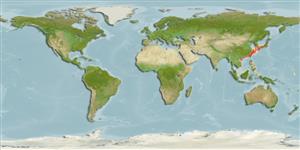Lớp phụ Cá sụn (cá mập và cá đuối) (sharks and rays) >
Carcharhiniformes (Ground sharks) >
Proscylliidae (Finback catsharks)
Etymology: Proscyllium: pro (L.), in front of, probably referring to far forward placement of dorsal fin compared with Scyllium (=Scyliorhinus, Scyliorhinidae). (See ETYFish); venustum: Latin for beautiful, probably referring to its spotted color pattern, as reflected in its local Japanese name Hyozame, meaning Leopard Shark [treated as a junior synonym of P. habereri by some workers]. (See ETYFish).
More on author: Tanaka.
Issue
Weigmann (2016; Ref. 106604) considered the species as valid (citing literature and pers. comm., p29), while as a synonym of Proscyllium habereri Hilgendorf, 1904 in ECoF. Considered here as a provisionally accepted species until further evidence.
Environment: milieu / climate zone / depth range / distribution range
Sinh thái học
Biển gần đáy; Mức độ sâu 50 - 100 m (Ref. 41299). Temperate
Northwest Pacific: Japan.
Bộ gần gũi / Khối lượng (Trọng lượng) / Age
Maturity: Lm ? range ? - ? cm
Max length : 60.0 cm TL con đực/không giới tính; (Ref. 41299)
Life cycle and mating behavior
Maturities | Sự tái sinh sản | Spawnings | Egg(s) | Fecundities | Ấu trùng
Oviparous, paired eggs are laid. Embryos feed solely on yolk (Ref. 50449).
Nakabo, T., 2002. Fishes of Japan with pictorial keys to the species, English edition I. Tokai University Press, Japan, pp v-866. (Ref. 41299)
IUCN Red List Status (Ref. 130435)
Threat to humans
Harmless
Human uses
Các công cụ
Special reports
Download XML
Các nguồn internet
Estimates based on models
Preferred temperature (Ref.
123201): 16.8 - 24.3, mean 22 °C (based on 41 cells).
Phylogenetic diversity index (Ref.
82804): PD
50 = 0.6328 [Uniqueness, from 0.5 = low to 2.0 = high].
Bayesian length-weight: a=0.00389 (0.00180 - 0.00842), b=3.12 (2.94 - 3.30), in cm total length, based on all LWR estimates for this body shape (Ref.
93245).
Mức dinh dưỡng (Ref.
69278): 4.1 ±0.6 se; based on size and trophs of closest relatives
Thích nghi nhanh (Ref.
120179): thấp, thời gian nhân đôi của chủng quần tối thiểu là 4.5 - 14 năm (Fec assumed to be <100).
Fishing Vulnerability (Ref.
59153): Moderate vulnerability (44 of 100).
